
9 minute read
Annex Marks the Spot
MUDS, Annexations, and Changing Rules
In 2019, the City of Houston collected $706.9 million in sales tax revenues, with $120.7 million (17.1 percent) collected from 230 suburban Municipal Utility Districts (MUDs) located outside the city limits.
This extraterritorial growth began in 2001 and continues to add new tax monies to the city’s coffers today (Figure 1). How did these extraterritorial collections come about, and what was their rationale under Texas annexation law?
The suburban revenues result from limited purpose annexations (LPAs), which—as used by the City of Houston—are potential general annexations suspended in mid-stream, but which are capable of generating city tax revenue for decades while the city provides no services to the suburbs. This use of LPAs has been made necessary by changes in Texas annexation law, suburban contentment with current services, the city’s poor handling of past annexations, and concern about city finances and debt levels. The MUD is the chief vehicle that makes Texas annexation work. It is often in a municipality’s extraterritorial jurisdiction (ETJ), which, for a large city like Houston, is a five-mile ring of land outside the city limits. Narrowly conceived as water districts in the 1920s and given modern form in 1971, the MUD is a parcel of land that prepares the way for future annexation by creating a land development company to provide water, sewer, drainage, and streets and roads. The MUD can finance development through bonds, fees, and property taxes. It is authorized and regulated under state law, but if located in a municipality’s ETJ, that city’s consent is required. The city imposes conforming municipal rules for land development intended to smooth the path for future general annexation. In 1994, Houston’s Kingwood subdivision was made up of three MUDs comprised of 15,000 acres and 53,000 residents. The City of Houston proposed general annexation, a process that at the time left Kingwood with little local input or legal recourse, but which local residents still turned into a bitter two-year public relations and legal battle. While Houston successfully completed the annexation in December 1996, the long-run fallout changed the course of Texas annexation law and ultimately proved costly to
Figure 1. Houston Sales Tax Revenue With/Without LPAs
200 180 Dollars (Millions) 160 140 120 100 80 60 1999 2001 2003 2006 2008 2010 2012 2015 2017 2019 Note: Dollar amounts are seasonally adjusted. Source: City of Houston City of Houston City + LPAs

the city. It was costly in that politically savvy Kingwood residents demanded and received sustained high service levels, cutting into any of Houston’s revenue windfall. But in 1999, partly in response to Kingwood, the Texas legislature required a three-year planning period for statewide general annexation, implementation of a joint strategic planning agreement (SPA) to merge services and finances, and remedies by law or arbitration if no agreement was reached. Finally, in 2017, the Texas legislature passed a bill to allow affected residents to vote on proposed annexation.
Special Purpose Annexation
Post-Kingwood, there has been no significant generalpurpose annexation in Houston. The cost of providing services to the suburbs has proven high and the net revenue gains from general annexation small. But the suburban revenue target still remained tempting for Houston.
The Kinder Institute at Rice University estimates that in 2015 the combined MUDs in Houston’s ETJ were comparable in size to the City of San Antonio, containing 1.5 6 million residents, 400 square miles, and 550,000 housing units. The LPA proved to be the map the city needed to find this suburban treasure chest.
Here’s an example of how an LPA is usually intended to work. A Texas city agrees to future general annexation with a MUD located in its ETJ, and they enter into a strategic partnership and an interim three-year partial annexation to blend service levels and finances. Both sides work toward an agreement where the city will match public service levels prevailing in the MUD before annexation, and the MUD accepts city water and sewage services, rates, and fees. Meanwhile, interim changes can be demanded. For example, the city is concerned about high debt levels in the MUD and demands debt be paid down by immediately imposing a 1 percent sales tax within the MUD. Once the SPA is in place, general annexation proceeds.
The Texas municipal code for SPAs was meant to be flexible, and the City of Houston has stretched its limits to arrive at a very different outcome. Houston approaches local MUDs seeking a strategic partnership while advertising a preference for limited over general annexation. The LPA as envisioned by the city, however, sees no city services provided except limited authority over planning, health, and safety, while MUD services continue unaffected. The city receives permission from the MUD to collect its one-cent municipal sales tax within MUD boundaries and turns half this money over to the MUD as a supplement to property taxes. The MUD must use these new funds for the same purposes as property taxes (water, sewage, streets, etc.). This “interim” SPA and a promise of no general annexation typically remains in force for 30 years, at which point the SPA can be renewed or terminated, or general annexation can be imposed.
The reviews of Houston’s LPAs have been widely mixed. Houston itself claims this is a commuter tax and frames the issue in terms of fairness: suburban commuters drain city services by day but add nothing to the tax base. The Kinder Institute broadly favors metropolitan annexation and Percent consolidation of MUDs into Houston and sees these agreements—which are not subject to a vote when they end—as perhaps the last and best hope for general regional annexation. In contrast, former Harris County Judge Ed Emmett said, “I think at their heart, they’re a money grab by the City of Houston . . . and they get the MUDs involved on the basis of ’We promise not to annex you.’”
City of Houston LPAs Today
LPAs spread mostly to the fast-growing suburbs north and northwest of Houston (see map). In 2019, just before the pandemic began, the City of Houston collected $120.7 million in taxes from 230 MUDs operating under LPAs and then split half these funds with participating MUDs.
LPAs’ Addition to Sales Tax Growth
2.5 2.0 Percent 1.5 1.0 0.5 0.0 2002 2003 2005 2006 2007 2008 2010 2011 2012 2013 2015 2016 2017 2018 LPA addition to growth After MUD split

Figure 2. LPAs’ Impact on Houston Sales Tax Growth
Sales Tax Growth With/Without LPAs
8 4 2 0 –2 –4 –6 2002 2003 2005 2006 2007 2008 2010 2011 2012 2013 2015 2016 2017 2018 City of Houston City + LPAs City after split
Source: City of Houston
LPA Spread to North, Northwest of Houston, 2017
290
99
Cypress Cypress
Cinco Ranch Cinco Ranch Tomball Tomball The Woodlands The Woodlands

Spring Spring
INTERSTATE
10
Jersey Jersey Village Village
8
INTERSTATE
45
INTERSTATE
610
INTERSTATE
69
Atascocita Atascocita
Houston ETJ LPAs (FY 2017)
MUD
Non-MUD
Fresno Fresno
Source: Kinder Institute, Rice University
Clear Clear Lake City Lake City

Compared with sales tax collected only within City of Houston boundaries, the new LPAs boosted total revenue growth by an additional 1.5 to 2 percent each year from 2004 to 2010, although that amount is cut roughly in half after MUD payments are subtracted (Figure 2).
This revenue growth has been slowing for some time, however. Leading this early surge in LPA revenue was the ability to target large numbers of existing MUDs, with a peak of 30 new LPAs added in 2003. But as the backlog of MUDs was exhausted, the number of new LPAs steadily slowed to only one or two LPAs each year after 2014.
Fewer new LPAs and ongoing MUD payments mean suburban collections will add only half a percentage point to future city sales tax growth.
However one feels about these LPAs, they are legal, and the Texas Municipal Code allows no judicial review of the rationale behind any annexation. Short of legislative change, SPAs will be in place for some time to come, but perceptions of fairness still count and certainly deserve further thought. Dr. Gilmer (rwgilmer@Central.UH.edu) is director with the University of Houston Bauer Institute for Regional Forecasting, and Fernandez (Adriana.Fernandez@tsu.edu) is with the Accounting/Finance Department, Jesse H. Jones School of Business, Texas Southern.
Is Houston’s tax on SPAs a commuter tax?
If so, it is poorly structured. A good commuter tax usually targets nonresident workers through a payroll tax on local businesses or by taxing autos entering the region. Only about 60 percent of Fort Bend commuters and 40 percent of Montgomery County commuters enter Harris County. The SPAs are a broader-based tax on suburban consumers.
Why a sales tax?
It is the vehicle required by law for partial annexation. As used by the strawman LPA in this article, it is a quick and highly efficient means for a municipality to raise funds for short-term pre-annexation goals. In contrast, the City of Houston has made it a 30-year longterm supplement to its sales tax revenue.
Why collect 1 percent and rebate half to MUDs? Why not just collect half?
With the threat of a general annexation waning, tax rebates become the carrot for MUD participation in SPAs that replace the annexation stick. While the rebate must be spent by the MUD for the same purposes as property taxes, extra revenue provides management new flexibility to reduce rates and fees, expand existing services, or add new ones.
Is the SPA tax fair: Horizontal equity?
Horizontal equity occurs if two similarly situated consumers face the same tax obligations. In this case, if two consumers buy the same basket of goods, do they pay the same amount in sales taxes? Since the 1980s, Houston has had a 1 percent sales tax that the suburbs had escaped. As the city has pushed its sales tax widely into the suburbs, it has increased horizontal equity across the region.
Is the SPA tax fair: Vertical equity?
Vertical equity requires that two taxpayers with the same income face the same tax obligations. The Texas sales tax is widely regarded as falling too heavily on the poor. But equally ill-structured property and franchise taxes are the chief Texas alternatives for broad-based tax collection and bring their own equity issues.
Is the City of Houston disproportionately burdened by the urban poor?
There is little question on this score. The U.S. Census Bureau measure of median household income from 2015 to 2019 is $52,338 for Houston, while Montgomery County and Fort Bend County (the region’s largest suburban counties) show $80,903 and $97,743, respectively. The poverty rate in the city is 20.1 percent versus 8.9 (Montgomery County) and 6.6 percent (Fort Bend County). But is the SPA the best way to deal with this problem? It raises revenue but fails to target the poverty problem meaningfully and specifically.







